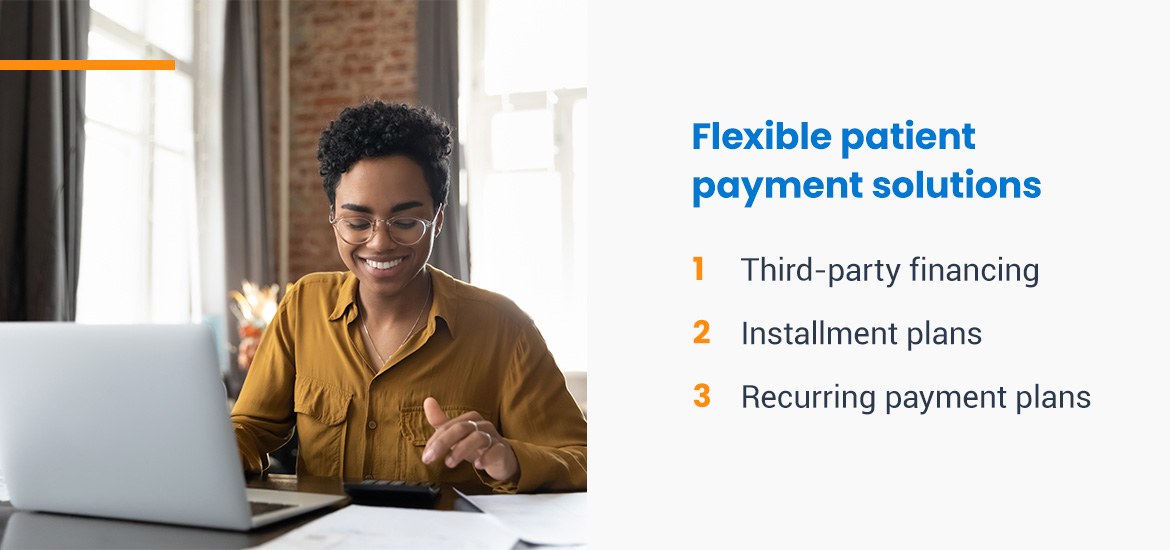In today’s complex healthcare landscape, a patient’s ability to pay is one of the most significant factors affecting care. Four in 10 Americans put off or postpone care due to the costs, even among those with insurance coverage (KFF, 2022a). Unexpected medical costs are one of the biggest concerns for many people. From high-deductible plans to increasing out-of-pocket costs, high healthcare expenses can cause more patients to forego or defer care, experience more stress, and take on more debt.
These challenges extend to the healthcare providers, too, who often find it harder to collect payments and offer care in an affordable manner. Flexible payment options can help providers bridge the gap and make care more affordable and less stressful for patients, regardless of their financial situation. These options offer personalization and peace of mind, with 63% of consumers expressing extraordinary interest in payment plans (PYMNTS.com & Rectangle Health, 2021) that could help them avoid bad debt.
The right patient payment solutions can benefit both patients and providers, offering flexible payment options for patients while improving reimbursements for providers.
Understanding the Financial Burden of Medical Expenses
Healthcare costs are more than a nuisance for most patients. Out-of-pocket expenses are higher than ever, and medical costs are rising (Telesford et al., 2023). With high-deductible plans, which over half of American workers have, many covered individuals still can’t meet costs (Waddill, 2023). Almost one in 10 adults now owe at least $250 in medical debt, including about 3 million people with over $10,000 owed (KFF, 2022b).
The burden of medical costs also hits providers. Providers might spend more resources chasing down payments or struggling to offer good care while staying within the patient’s budget. High costs can also cause patients to go elsewhere or forego care, preventing the provider from providing their services. Unexpected or high costs could lead to dissatisfied patients, too, hurting the provider’s reputation and ability to serve more people.
With so many patients acting as their own payers, many providers have begun to look for ways to make payments easier and more attainable. While some cookie-cutter healthcare payment methods offer support, they are still out of reach for many patients. For example, many plans require minimum credit scores or predetermined payment amounts that don’t account for the patient’s capabilities or the unpredictable aspects of everyday life.
Flexible, personalized payment plans make room for the patient’s unique situation and unexpected events, so patients can ease their financial burdens and providers can increase payments and satisfaction ratings.
Flexible Patient Payment & Financing Solutions
Flexible patient payment solutions can allow the patient to pay for their care over time with low-stress, manageable payments. It can provide peace of mind for both urgent and routine care by allowing them to create a plan. Patients can seek care without worrying about paying several hundred dollars before they get their next paycheck, which can help prevent them from avoiding necessary visits.
On the provider’s side, flexible options can help improve patient satisfaction ratings and reduce the time spent collecting payments. Employees can focus on care instead of finances, and the practice benefits from faster cash flow.

Below are three common flexible patient financing options:
1. Third-party financing
In a third-party financing arrangement, the provider offers financing provided by a third party, similar to how a retail store might offer a credit card. It relieves the provider of the complexities of financing and acts as a lender while providing fast, dependable payments. Patients get a predictable monthly fee that removes many barriers to care.
These arrangements also offer a few advantages over consumer credit cards. They may involve special perks like low-interest payments, and they usually have more relaxed or nonexistent credit score requirements.
2. Installment plans
Installment plans are similar to third-party financing solutions in that the patient still pays their balance at regular intervals. They must pay the entire bill by a specific date. Instead of being managed by another company, the healthcare provider typically manages installment plans. You would get more control over the program, but you would also take on the risks of collecting payment.
These plans allow you to keep billing in-house and offer patients an easier way to budget, spreading out costs over time.
3. Recurring payment plans
Unlike installment plans, a recurring payment plan has no specific end date. Patients might use it to make regular, fixed payments, usually toward long-term care, ongoing treatments, or expensive specialist services. It also provides a more predictable, low-stress way of paying for care but leaves room for anticipated changes. Typically, the healthcare provider manages this type of plan and takes on the risk.
Patient Payment Options that Work
The right healthcare payment method can vary by patient, provider, service, and many other factors, but consumers have demonstrated a clear desire for convenient, flexible systems. We’ve found that many of the most loyal patients will consider switching providers for one that offers better digital resources, such as payment options (PYMNTS.com & Rectangle Health, 2021). Plus, offering flexibility is an excellent way to get patients to pay their bills. Whichever approach you use in your practice, it should include features like:
- Card-on-file (CoF) storage: A card-on-file solution allows providers to securely store patient card information in the payment platform. Patients can then easily make payments without tracking down their credit cards. Office staff can collect payment over the phone or through digital registration forms.
- 24/7 payments: Digital payments allow patients to pay their bills at any time, regardless of whether the provider’s office is open. This simple feature offers significant convenience and can make a patient more likely to submit payments.
- Automatic payments: With a card on file, you can set up automated set-and-forget payments. Patients don’t need to remember to pay a bill on time, and you can get more reliable cash flow.
- Security: Any digital tool in a healthcare environment must abide by the Health Insurance Portability and Accountability Act (HIPAA). Look for a secure and encrypted solution that meets HIPAA requirements, as well as other applicable standards.
Find a Flexible Payment Solution for Your Practice with Rectangle Health
The team at Rectangle Health has been developing innovative, dependable payment technology for almost 30 years, helping providers and patients reap the benefits of convenient and flexible payment choices. We can help you set up installment or recurring plans, or we can provide third-party financing with our patient financing program*. It’s all easy to manage and built into the Practice Management Bridge®, our powerful yet easy-to-use practice management software.
Give your patients as many medical financing options as possible. From text-to-pay solutions to contactless payments, the Practice Management Bridge® can help you accommodate even the most unique situations and appeal to more patients. Explore all of our payment solutions online.
* The Paitent Financing program provides nearly 100% approval. Applicants determined to be in Open Bankruptcy, Fraud Alert or on the Terrorist Watch List during the application process will be declined. Patients covered by government payor programs for a procedure are not eligible for financing of that procedure. Government payer programs include Medicare, Medicaid, the State Children’s Health Insurance Program (SCHIP), the Department of Defense TRICARE and TRICARE for Life programs (DOD TRICARE), the Veterans Health Administration (VHA) program, and the Indian Health Service (IHS) program.
References
- KFF. (2022a, March 10). 1 in 10 adults owe medical debt, with millions owing more than $10,000. KFF. Retrieved April 1, 2023, from https://www.kff.org/health-costs/press-release/1-in-10-adults-owe-medical-debt-with-millions-owing-more-than-10000/
- KFF. (2022b, July 14). Americans’ challenges with health care costs. KFF. Retrieved April 1, 2023 from https://www.kff.org/health-costs/issue-brief/americans-challenges-with-health-care-costs/
- PYMNTS.com & Rectangle Health. (2021). (rep.). Healthcare Payment Experience Report. Retrieved April 1, 2023, from https://www.pymnts.com/study/healthcare-payment-experience-rectangle-health-digital-medical/.
- Telesford, I., Telesford, I., Rakshit, S., McGough, M., Twitter, E. W., & Twitter, K. A. (2023, February 7). How has U.S. spending on healthcare changed over time? Peterson-KFF Health System Tracker. Retrieved April 1, 2023, from https://www.healthsystemtracker.org/chart-collection/u-s-spending-healthcare-changed-time/
- Waddill, K. (2023, February 9). High deductible health plan enrollment hit record high in 2021. HealthPayerIntelligence. Retrieved April 1, 2023, from https://healthpayerintelligence.com/news/high-deductible-health-plan-enrollment-hit-record-high-in-2021




